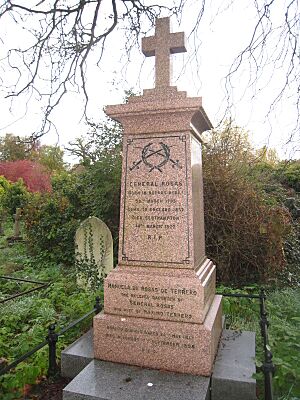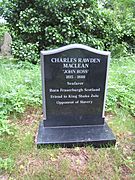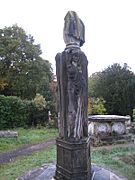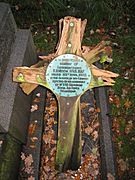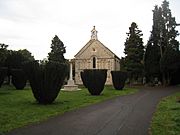Southampton Old Cemetery facts for kids

Graves in the Old Cemetery
|
|
| Lua error in Module:Location_map at line 420: attempt to index field 'wikibase' (a nil value). | |
| Details | |
|---|---|
| Established | 7 May 1846 |
| Location |
Cemetery Road, Southampton
|
| Country | England |
| Type | Municipal |
| Owned by | Southampton City Council |
| Size | 27 acres (11 ha) |
| No. of graves | 116,800 |
The Southampton Old Cemetery is a historic burial ground in Southampton, England. It has been known by different names, like The Cemetery by the Common. This cemetery covers about 27 acres of land. Over the years, around 116,800 people have been buried here. Today, only a few burials happen each year in existing family plots.
Contents
History of the Cemetery
The idea for the cemetery began in 1841. Southampton Town Council wanted to create a new burial ground. They needed a special law, called an Act of Parliament, to use land from Southampton Common.
Designing the Cemetery
The council first asked John Claudius Loudon for help. He was a famous designer of gardens and cemeteries. Loudon was in Southampton at the time, which was very convenient. He was paid for his ideas, but the council decided not to use his plan. This was partly because religious leaders disagreed on how the chapels should be built.
So, the council held a competition for new designs. William Rogers, a local plant seller and council member, won. His design was chosen for the cemetery.
When the Cemetery Opened
The cemetery officially opened on May 7, 1846. A part of the grounds was blessed for Anglican Christians. Other areas were set aside for different Christian groups, called non-conformists, and for people with no religious beliefs. In 1856, a section was also given to the Roman Catholic community.
The cemetery started as a 10-acre site. More land was added in 1863, making it 15 acres. In 1884, another 12 acres were added, bringing it to its current size.
Who is Buried Here?
The cemetery is the final resting place for many interesting people.
- Titanic Memorials: There are 60 headstones linked to the Titanic disaster. However, no bodies from the ship were brought back to Southampton.
- General Rosas: General Rosas was an important politician from Argentina. He was buried here after being exiled from his home country. In 1989, his body was moved back to Argentina. His tomb in Southampton remains as a memorial. His grandson, Manuel Terrero, and his wife, Janie Terrero, who fought for women's right to vote, are also buried here.
- Edward Askew Sothern: This famous Victorian comedy actor is buried in the cemetery. He was well-known for his role as Lord Dundreary.
- Edwin Moon: Edwin Moon was a pioneer in aviation, meaning he was one of the first people to fly planes. His gravestone is unique because it was made from the propeller of the aircraft he was flying when he died in 1920.
- War Graves: The cemetery has 140 graves of soldiers who died in wars. These graves are cared for by the Commonwealth War Graves Commission. Most are from World War I, and some are from World War II. There is also a special area for 21 Belgian soldiers.
- Charles Rawden Maclean: Known as "John Ross," he was a friend of King Shaka of the Zulu nation. He was against slavery. He died on a ship and was buried in a simple, unmarked grave. In 2009, a headstone was placed on his grave.
- Charlie Barr: Charlie Barr was a famous sailor who won the America's Cup sailing race three times. He is also buried here.
- RMS Rhone Memorial: There is a memorial for the RMS Rhone. This ship was wrecked in a hurricane in 1867, and over 120 people lost their lives. The memorial was damaged by vandals in 2011.
- Pearce Family Grave: The grave of the Robert Pearce family has a beautiful sculpture. It shows the figures of Faith, Hope and Charity. This memorial was created by Richard Cockle Lucas and is considered a historically important structure.
Important Buildings and Memorials
Many buildings and some memorials in the cemetery are "Grade II listed." This means they are important historical structures that need to be protected.
- Former Jewish Mortuary Chapel (now part of a house)
- Church of England Mortuary Chapel
- Allen Memorial (a grand stone tomb)
- Lodge (a small house at the entrance)
- Gate piers to the eastern gate (parts of the gate structure)
- Pearce Memorial (the sculpture mentioned above)
- Wall fronting Hill Lane (the wall along the road)
- Gates and gate piers (at the main entrance)
- Nonconformist Mortuary Chapel
- Gate piers to the north-western gate
Cemetery Wildlife
The cemetery is also home to various plants and animals. A special team from Southampton City Council works with a group called "Friends of Southampton Old Cemetery" to look after the wildlife. This volunteer group also gives tours and helps families care for graves.
Gallery
-
The gravestone of "John Ross"
-
Edwin Moon's grave marker


